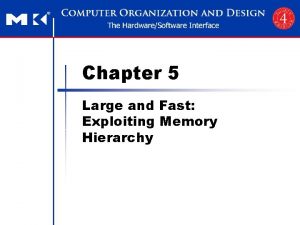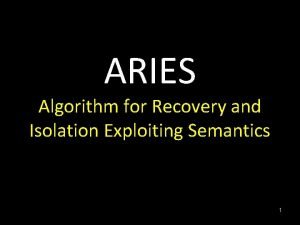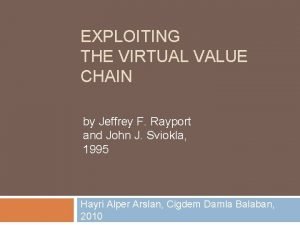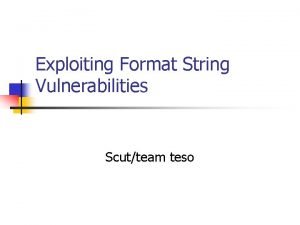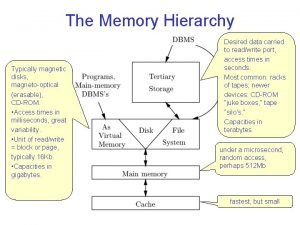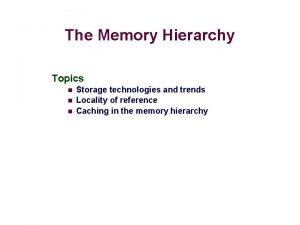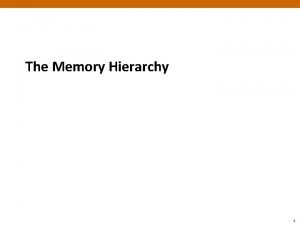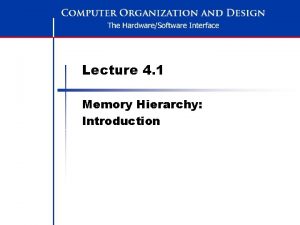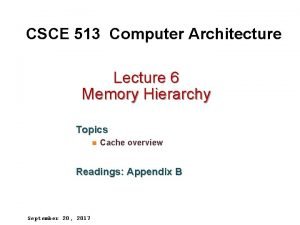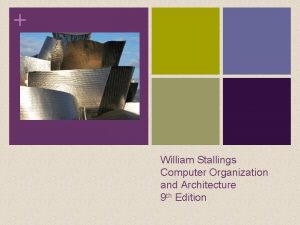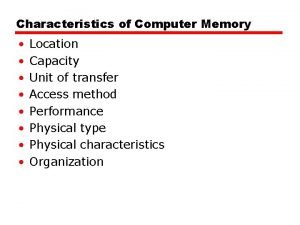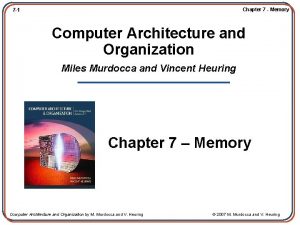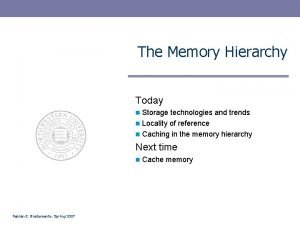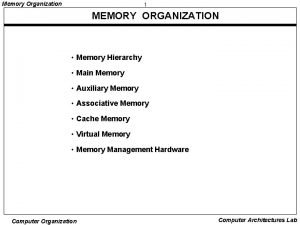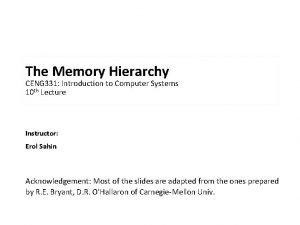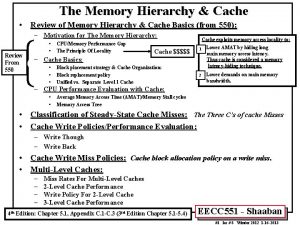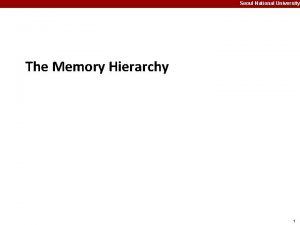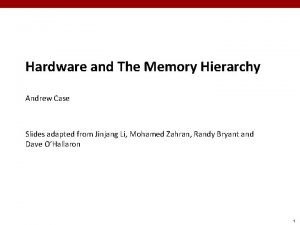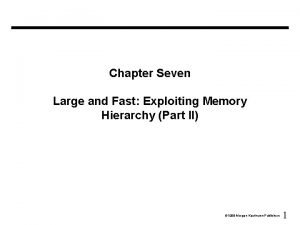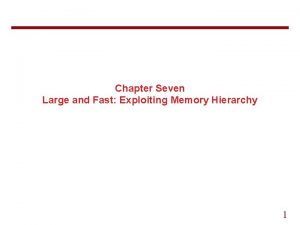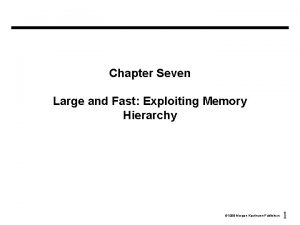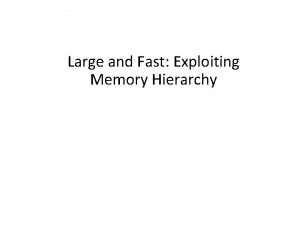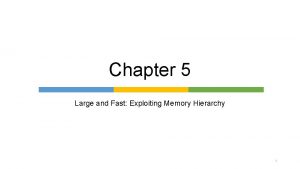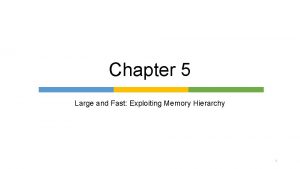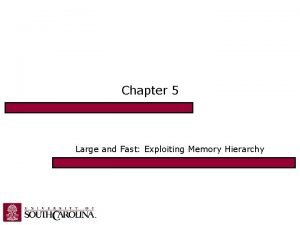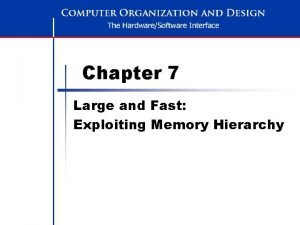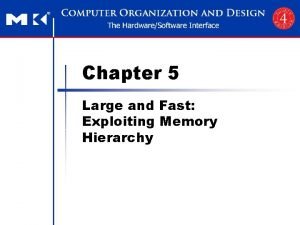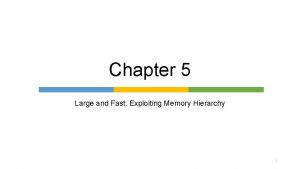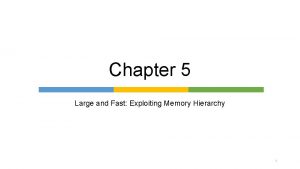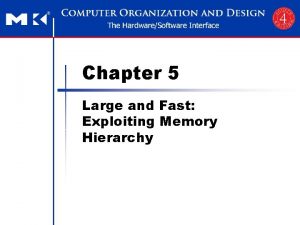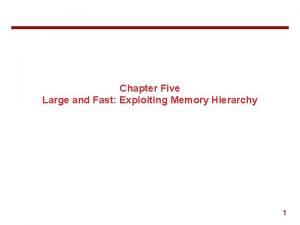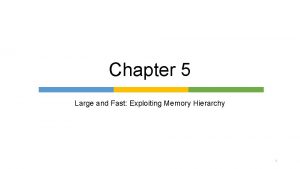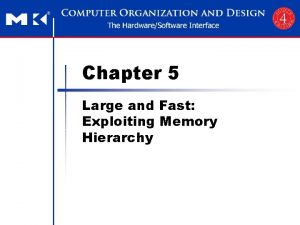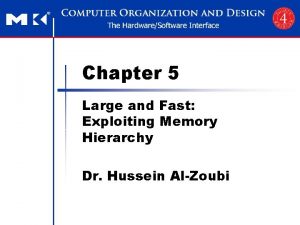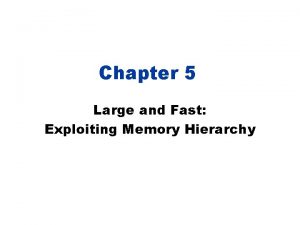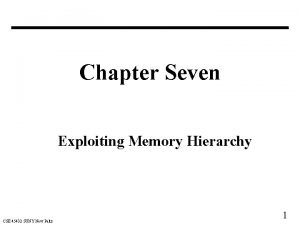Chapter Seven Large and Fast Exploiting Memory Hierarchy

































- Slides: 33

Chapter Seven Large and Fast: Exploiting Memory Hierarchy 1

7. 1 Introduction • SRAM: – value is stored on a pair of inverting gates – very fast but takes up more space than DRAM (4 to 6 transistors) • DRAM: – value is stored as a charge on capacitor (must be refreshed) – very small but slower than SRAM (factor of 5 to 10) 2

• There are three primary technologies used in building memory hierarchies: 1. DRAM (main memory) 2. SRAM (caches) 3. Magnetic Disk 3

Locality • A principle that makes having a memory hierarchy a good idea • If an item is referenced, temporal locality: it will tend to be referenced again soon spatial locality: nearby items will tend to be referenced soon. Why does code have locality? • Our initial focus: two levels (upper, lower) – block: minimum unit of data – hit: data requested is in the upper level – miss: data requested is not in the upper level 4

• • Users want large and fast memories! Build memory as a hierarchy of levels (fastest is close to the processor. 5

• • Hit rate Miss rate Hit time Miss penalty 6

7. 2 The Basic of Caches • • Two issues: – How do we know if a data item is in the cache? – If it is, how do we find it? Our first example: – block size is one word of data – "direct mapped" For each item of data at the lower level, there is exactly one location in the cache where it might be. e. g. , lots of items at the lower level share locations in the upper level 7

Direct Mapped Cache • Mapping: address is modulo the number of blocks in the cache 8

Accessing a Cache Example: An eight-word direct-mapped cache 9

Direct Mapped Cache • For MIPS: What kind of locality are we taking advantage of? 10

Example: Bits in a Cache How many total bits are required for a direct-mapped cache with 16 KB of data and 4 -word blocks, assuming a 32 -bit address? ----------------------16 KB = 4 K words = 212 words Block size = 4 words(22), 210 blocks Each block has 4 32=128 bits of data plus a tag(32 -10 -2 -2 bits) Thus: the total cache size = 210 (128+(32 -10 -2 -2)+1) = 210 147 = 147 Kbits 11

Example: Mapping an Address to a Multiword Cache Block Consider a cache with 64 blocks and a block size of 16 bytes. What block number does byte address 1200 map to? ------------------(Block address) modulo (Number of cache blocks) where the address of the block is: Notice that this block address is the block containing all address between: Thus, with 16 bytes per block which map to cache number (75 modulo 64) = 11 12

Direct Mapped Cache • Taking advantage of spatial locality: 13

Hits vs. Misses • Read hits – this is what we want! • Read misses – stall the CPU, fetch block from memory, deliver to cache, restart • Write hits: – can replace data in cache and memory (write-through) – write the data only into the cache (write-back the cache later) • Write misses: – read the entire block into the cache, then write the word 14

Hardware Issues • Make reading multiple words easier by using banks of memory • It can get a lot more complicated. . . 15

Performance • Increasing the block size tends to decrease miss rate: • Use split caches because there is more spatial locality in code: 16

Performance • Simplified model: execution time = (execution cycles + stall cycles) cycle time stall cycles = # of instructions miss ratio miss penalty • Two ways of improving performance: – decreasing the miss ratio – decreasing the miss penalty What happens if we increase block size? 17

Decreasing miss ratio with associativity Compared to direct mapped, give a series of references that: – results in a lower miss ratio using a 2 -way set associative cache – results in a higher miss ratio using a 2 -way set associative cache assuming we use the “least recently used” replacement strategy 18

An implementation 19

Performance 20

Decreasing miss penalty with multilevel caches • Add a second level cache: – often primary cache is on the same chip as the processor – use SRAMs to add another cache above primary memory (DRAM) – miss penalty goes down if data is in 2 nd level cache • Example: – CPI of 1. 0 on a 5 Ghz machine with a 5% miss rate, 100 ns DRAM access – Adding 2 nd level cache with 5 ns access time decreases miss rate to. 5% • Using multilevel caches: – try and optimize the hit time on the 1 st level cache – try and optimize the miss rate on the 2 nd level cache 21

Cache Complexities • Not always easy to understand implications of caches: Theoretical behavior of Radix sort vs. Quicksort Observed behavior of Radix sort vs. Quicksort 22

Cache Complexities • Here is why: • Memory system performance is often critical factor – multilevel caches, pipelined processors, make it harder to predict outcomes – Compiler optimizations to increase locality sometimes hurt ILP • Difficult to predict best algorithm: need experimental data 23

Virtual Memory • Main memory can act as a cache for the secondary storage (disk) • Advantages: – illusion of having more physical memory – program relocation – protection 24

Pages: virtual memory blocks • Page faults: the data is not in memory, retrieve it from disk – huge miss penalty, thus pages should be fairly large (e. g. , 4 KB) – reducing page faults is important (LRU is worth the price) – can handle the faults in software instead of hardware – using write-through is too expensive so we use writeback 25

Page Tables 26

Page Tables 27

Making Address Translation Fast • A cache for address translations: translation lookaside buffer Typical values: 16 -512 entries, miss-rate: . 01% - 1% miss-penalty: 10 – 100 cycles 28

TLBs and caches 29

TLBs and Caches 30

Modern Systems • 31

Modern Systems • Things are getting complicated! 32

Some Issues • Processor speeds continue to increase very fast — much faster than either DRAM or disk access times • Design challenge: dealing with this growing disparity – Prefetching? 3 rd level caches and more? Memory design? 33
 Large and fast: exploiting memory hierarchy
Large and fast: exploiting memory hierarchy Virtual memory in memory hierarchy consists of
Virtual memory in memory hierarchy consists of Acid fast and non acid fast bacteria
Acid fast and non acid fast bacteria Differentiate between acid fast and non acid fast bacteria
Differentiate between acid fast and non acid fast bacteria Generation of a new entry opportunity
Generation of a new entry opportunity Aries recovery algorithm
Aries recovery algorithm 7 deadly sins and heavenly virtues
7 deadly sins and heavenly virtues The virtual value chain
The virtual value chain Exploiting format string vulnerabilities
Exploiting format string vulnerabilities Exploiting machine learning to subvert your spam filter
Exploiting machine learning to subvert your spam filter What is a sport/event entity?
What is a sport/event entity? Internal memory and external memory
Internal memory and external memory Primary memory and secondary memory
Primary memory and secondary memory Page fault
Page fault Magnetic disk in memory hierarchy
Magnetic disk in memory hierarchy Memory hierarchy of computer system
Memory hierarchy of computer system Memory hierarchy
Memory hierarchy Memory hierarchy in os
Memory hierarchy in os Explain memory hierarchy
Explain memory hierarchy Memory hierarchy in computer architecture
Memory hierarchy in computer architecture Memory hierarchy in computer architecture
Memory hierarchy in computer architecture Computer memory hierarchy diagram
Computer memory hierarchy diagram Memory hierarchy definition
Memory hierarchy definition Computer memory hierarchy diagram
Computer memory hierarchy diagram Hit ratio in computer architecture
Hit ratio in computer architecture Hierarchy of trends
Hierarchy of trends Memory hierarchy pyramid
Memory hierarchy pyramid Memory hierarchy
Memory hierarchy Draw memory hierarchy diagram
Draw memory hierarchy diagram Memory hierarchy
Memory hierarchy Virtual memory tlb
Virtual memory tlb Memory hierarchy
Memory hierarchy Semantics prototype
Semantics prototype Implicit explicit memory
Implicit explicit memory
